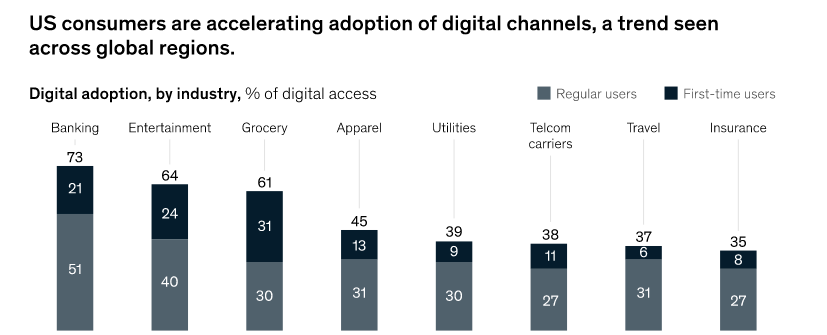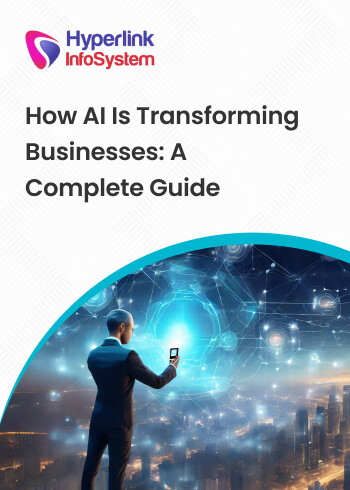One thing that we have realized during these turbulent times is the importance for businesses in every sector to reinvent how they work if the circumstances demand it.
It is fair to assume a challenge exists for every company to respond efficiently to this new situation created by the COVID-19 pandemic. Spearheading the push towards that is technology—chatbots, video conferencing platforms, and online shopping & delivery apps are some of the technologies that come to mind.
According to an article published by Mckinsey, consumers in the U.S have increased their adoption of digital channels since the outbreak of the coronavirus pandemic. This is illustrated by the following infographic that shows digital adoption by the industry as of April 2020.
(Consumer Digital Adoption by Industry as of April 2020 [Image Source])
Not only are consumers in every sector increasingly adopting digital channels, but they also consider digital interactions to be twice as important as they were before the outbreak of the COVID-19 pandemic. The following infographic from a different study from McKinsey illustrates this.
(Traditional and digital-enabled sales interactions before and after the outbreak of the COVID-19 pandemic [Image Source])
The above is a clear indication of the shift in customer behavior and preferences since the outbreak of the coronavirus pandemic. More and more consumers now want their interactions with businesses to be digital rather than in-person. This is understandable under the current circumstances, and air of uncertainty regarding when a tested and approved coronavirus vaccine will become available.
Till that time, consumers would want to adhere to social distancing protocols set by the government and healthcare organizations. Perhaps, there is no better way to do this than keeping all interactions remote or digital. We already see this in the shape of the rapidly increasing consumer digital adoption across industries.
However, it isn’t just consumers that are becoming increasingly digitized. Businesses are also doing the same by enforcing remote working and operations in their organization.
The Digital Transition of the Workplace
Since the outbreak of the COVID-19 pandemic, organizations have been changing how they work and conduct their business. One of the mainstays of this rapid transformation of business operations is remote working. We’ve witnessed remote working skyrocket during COVID-19 lockdowns and this will continue to grow at least until a vaccine for coronavirus becomes available. The following infographic from a Mckinsey study shows the share of remote working employees across industries in the U.S during April 2020:
(Share of employees working remotely full time in various U.S industries during April 2020 [Image Source])
Slowly but surely remote working will become the norm as businesses begin to realize the potential savings and productivity improvements that can be achieved with it.
Every business out there needs to understand that the concept of a workplace is no more confined to a physical entity. The influx of technology has made it convenient for the organizations to take the entire office setup to the employees instead of requiring them to drop in for work. As digital takes a toll over the physical premises, the demarcation between the physical and cloud-based office entities are fast turning extinct. Digital, virtual, and cloud-based is the future face of the workplace.
Many organizations worldwide have already plunged into this digital overhaul. However, it is important to understand that just like a digital workplace comes with its special perks, it will also demand a change in the management approaches, to deliver up to its utmost potential. Here's some insight into the future face of a digital workplace, its key attributes, and why the organizations need to prepare for a giant leap towards digital.
Understanding a Digital Workforce
The concept of a digital workplace is still emerging, therefore, there is no specific standard to define a digital workplace in its absolute entirety. However, as per the popular perception, a digital workplace is the gradually and systematically transformed workplace that is primarily driven by advanced, tech-oriented systems and algorithms, and holds an immense capacity to be tailored and customized as per the changing needs of time and the organization’s needs.
The Key Attributes of a Digital Workplace
A digital workplace features many prime attributes that give it a superior advantage over the typical physical office premises. Remote accessibility, real-time virtual networking, automated management, and operational designs, and flexibility in job designs are some of the major distinguishing features. Aside from that, a digital workplace drives on the following factors:
• Networking, Collaborations, and Instantaneous Communications
• Technology
• Automated administration through smart workforce management systems and mobile applications
• Smart Business Tools for accurate insights and analysis
The Need to Switch Over to a Digital Workplace
The success of a business in the future will be primarily driven on the adaptability of a business to develop strategic coherence between its workforce, technology, and the workplace. The ideal integration of these prime pillars will foster a thriving organization that is digitally advanced and generates optimal returns. Here's how a digital transition will benefit the business organizations:
Retaining a dedicated workforce – A digital workplace through its flexible job designs will attract new talent and retain the existing workforce.
Optimal productivity – Digital handling and processing of business operations will leverage the bar of production as well as productivity.
Increased employee morale and job satisfaction – The use of smart tools will make tasks more convenient and hassle-free, eventually casting a positive impact on employee morale and productivity.
Better communication designs – A digital workplace will ensure an instant and smooth sharing of information that is accurate and reliable.
Instant and real-time assessment of tasks – The instant check and balance controls and analytical tools will make it convene to assess the progress and status of tasks, in real-time, as and when they are performed.
In addition to moving to remote working, another step that organizations can take to minimize the impact of COVID-19 on their business is leveraging technology to make key business decisions.
Using Technology to Make Key Business Decisions in a Post COVID-19 World
Under the current situation, making the right decisions is critical for every organization because even one wrong decision could be the difference between the growth and insolvency of the business. The good news is that most organizations already realize this and which is reflected in the 2020 COVID-19 impact survey by Dresner Advisory Services that shows that business decisions based on data and analytics are fast becoming a necessity for businesses who want to survive and ultimately thrive. The following is an illustration of this:
(BI and Analytics Projects since the outbreak of the COVID-19 pandemic [Image Source])
From the above infographic, we find that while there has been a delay in 39% of the BI and analytics projects since the outbreak of the COVID-19 pandemic in addition to 8% canceled projects, 10% new projects have been launched and 39% are moving forward without any delay. In the next few months, we can expect a good majority of delayed projects to restart and move forward with full throttle.
Why is that? Because, for any business, one of the most important and significant activities is decision making. For long, technology such as information systems has been used to support business operations. However, the use of technology for business decision making is a relatively new practice. Today, many business owners and senior executives are using business intelligence to make important business decisions.
After filtering out the important facts from a tremendous amount of unstructured information, business intelligence transforms the extracted data into actionable information. This actionable information is used by businesses to make informed decisions, improve operations efficiency, and increase productivity. In short, technology is helping business owners to make better decisions. The following are 4 ways how.
1. Improved Enterprise Resource Planning
Today, an increasing number of developers are developing customized enterprise resource planning software for businesses to help them meet their planning and decision-making needs. The majority of the big corporations already use ERP to ensure that all departments, including sales, manufacturing, finance, and accounting are on the same page. In addition to ensuring better collaboration between departments, this allows management to make informed decisions.
2. Better Data Processing Capabilities
By allowing you to go through a considerable amount of data quickly, technology helps you to make business decisions faster. Also, if you want, you can automate the entire decisions making process by using the data mining tools present in the data warehouse.
3. Improved Business Analysis
While big corporations can have a devoted business analytics department, the smaller businesses will find it extremely difficult to afford a professional business analyst. For such businesses, a good thing to do would be using a business analysis tool. Using this tool, small business owners can view and analyze a large amount of data. By looking at the facts and figures provided by the analysis tool, businesses can easily make key business decisions.
4. Enabling Group Decision-Making
That day isn’t far when technology overtakes human intellect. A step in that direction is the concept of a decision support system. While the concept isn’t new, its role in business operations and decision-making has increased considerably in the past few years. By organizing raw data and allowing businesses to foresee problems, DSS improves business decision making. In simple terms, by providing them actionable information, a decision support system helps businesses to make informed decisions.
DSS is something business teams will find extremely useful. A business team can make quick decisions by using a group decision support system (GDSS). A type of decision support system, a group decision support system facilitates a team’s problem-solving activities. To facilitate business decision making, GDSS integrates telecommunications, DSS capabilities, and groupware.
Technology is making a lot of things easy for businesses including decision-making. As a result, we’re seeing a massive adoption of business intelligence (BI) and analytics software and mobile apps. Another technology trend that has been growing in the business world, especially, since the outbreak of the COVID-19 pandemic is DevOps adoption.
The Increasing Adoption of DevOps
DevOps adoption is a growing trend in the business world, especially in IT enterprises. Just to give you an idea of the growing popularity of DevOps amongst organizations, the DevOps market is forecasted to grow at 20% over the next six years to reach
$17 billion by 2026.
Additionally, according to a survey by Help Net Security—a website that provides news and information on enterprise security, DevOps adoption is increasing worldwide. The survey, which included over three thousand businesses from twenty-one different countries showed the various departments in an organization using DevOps, the adoption rate at different levels of the hierarchy, and the stage of DevOps adoption they were at. This is illustrated by the following infographic:
(DevOps adoption across functions and organizational hierarchy in 3000+ organizations from 21 different countries [Image Source])
The above infographic shows that it is not the IT department in an organization that is adopting DevOps, but other functions/departments in an organization are also warming up to it.
So, it’s established that more and more enterprises today are adopting DevOps but what does the term refer to exactly? A philosophy or cultural change, DevOps strives to increase cooperation between operation and software development to deliver small releases to the market more often. DevOps facilitates collaborative change by demanding a linked toolchain of technologies and merging operations with development.
By transitioning to DevOps, an organization enables continuous production, prompt problem-solving, and enhanced value of its software/ applications. While all enterprises can make the switch to DevOps, there are certain prerequisites for DevOps transformation, and these include collaboration, organizational structure, automation, culture, and leadership. Perhaps, culture and leadership are the most important of these prerequisites and thus, the need to discuss them.
Why DevOps Starts with Leadership and Culture
The key to a successful DevOps transformation is not about having expertise in specific toolsets rather it is about building a culture that promotes collaboration and continuous automation and improvement. Tools are important in DevOps transformation, but they will hold little value if the team/organizational culture does not fit the transformation. Who is responsible for building a culture for DevOps transformation? It is the DevOps team leader.
The culture for DevOps transformation is a culture focused on realigning the roles of operations, testers, and developers who frequently struggle to communicate effectively when working on a project. Communication and collaboration between teams that aim to set clear objectives and tasks, optimize efforts, and increase overall collaboration for problem-solving are used to reinforce this culture. All of this is the responsibility of the DevOps leader.
A leader must connect the DevOps activities and break down silos to build a powerful organizational structure for DevOps transformation. To make DevOps as minimally disruptive as possible, a DevOps leader must get buy-in from all the stakeholders. The leader must show the value DevOps brings to the organization and then evaluate the staff levels and the qualifications of the personnel involved.
The leaders must ensure that those involved in DevOps transformation not only have infrastructure and development skills but also have strong troubleshooting and problem-solving skills. Additionally, the person must have a will to use data as one of the key elements to success and this use of data should not be limited to making applications work, rather it should extend to improving and automating the process, ensuring that applications work better and require less management. While DevOps starts with leadership and culture, a lot more is required for making a sustainable transformation. The things enabling a sustainable DevOps transformation are discussed next.
What Makes a Sustainable DevOps Transformation
Successful DevOps transformation is easier said than done. For a successful and sustainable DevOps transformation, it is critical to understand that DevOps is not a methodology; rather it is a philosophy, a cultural change that emphasizes collaboration and communication between software developers and other professionals in an enterprise. The purpose of this is to increase the speed, frequency, and reliability with which software is built, tested, and released.
So, how can organizations and DevOps leaders ensure a sustainable DevOps transformation keeping in mind the above definition of DevOps? As a technology leader helping organizations transform and succeed in IT delivery, I would recommend the following seven steps to empower teams to enable a sustainable DevOps transformation.
1. A Sense of Urgency for the Transformation
Starting as early as possible is crucial because effective DevOps transformation will take time. This sense of urgency should not be limited to the leader; rather it should be passed down throughout the team and company. Also, to enable team members to see their efforts are worthwhile, benchmark against other companies to provide a quantifiable measurement.
2. A Team Vision
The backbones of any DevOps transformation are the team members supporting the change. The transformation should involve senior IT management, but only if they have the right attitude. No matter how skilled or experienced they are, people resisting change should not be part of the transformation. Additionally, you align DevOps with the vision of continuous delivery; the scope should cover all aspects of DevOps, but it allows for narrowing the focus to focus on continuous delivery when required.
3. A Focus on Communication
Collaboration should be very much a team effort since DevOps revolves around it. Feedback and input are essential for the transformation, which means that vision and roadmap should be communicated once decisions are made. This will help to achieve visibility and build trust.
4. Empowering DevOps Team Members
The transfer of power and trust is required for DevOps transformation. When forging new collaborations and methods, DevOps team members must be allowed to be autonomous. This will reduce complexity and allow the team members to work more efficiently.
5. Team Building
Team building produces an overall guiding coalition and this coalition aims to remove obstacles that may hinder the DevOps transformation. The key to team building for DevOps transformation is quickly replacing any structures that undermine team vision and encouraging avant-garde thinking and risk-taking.
6. Short-Term Wins
The impact of DevOps practices should be exhibited wherever possible. To prove ROI, visible results must be delivered to the business and the increase in release velocity can be shown through pilot projects using more established team members.
7. Establishing Change and Increasing the Scale
For long-term success, methods of experiments that worked well should be embedded into the culture. This may mean changing long-standing practices, so you may need to make some brave decisions. The credibility of the pilot schemes can be used to prove the viability of the new systems, but make sure to allow each team to practice their methodology if it helps them work faster. Also, governance frameworks should be avoided as agility is the key to increasing velocity. After some time, the new methodologies will become part of the standard practices.
How to Make the Relationship Between Lean, Agile, and DevOps Work for You
Today, IT organizations are continuously searching for sustainable ways to scale their service capacity. Not only do they need to manage the increasing demand, but they also need to develop an efficient, sustainable process that allows them to scale safely. Leading workflow and concepts such as lean, agile, and DevOps are known to be both efficient and sustainable, thus attracting attention from many IT organizations looking to scale.
Both agile and DevOps have a common (lean) goal. The aim is to improve the speed and quality of value delivery. However, they differ in their breadth of focus. Agile looks to optimize software development, but it does not consider other parts of the IT value stream. Recognizing this, DevOps pushes the constraint downstream to Ops, breaking down walls between the two. Lean looks to optimize the entire value stream by broadening the focus.
For a sustainable DevOps transformation, the most important thing to making the relationship between lean, agile, and DevOps work for you is knowing what is truly Lean, DevOps and agile, where each intersects and where the discrepancies are.
While DevOps adoption can help an organization to scale its IT capacity to better manage the fluctuations in demand caused by the COVID-19 pandemic, moving to the Cloud will help ensure seamless customer service.
How Moving to the Cloud Can Help Businesses Improve Customer Service during the Pandemic
The current COVID-19 pandemic—and the global response to it—has forced companies to completely rethink their plans and how they work. One of the biggest changes that have happened since the outbreak of the pandemic is that many new companies have started to make a move to the Cloud. Seeing this, MarketsandMarkets predicts the Cloud Applications Market to grow at a CAGR of
15.8% from US$ 171 billion in 2020 to US$ 356 by 2025.
Businesses are making a move to the cloud for many purposes including ensuring seamless customer service. For any business, customers are of the utmost importance. Businesses that provide great customer service can retain existing customers and win new business. Despite this, many businesses today pay little heed to improve their customer service. This is a huge mistake as customer satisfaction is one of the few ways business owners can improve their business and increase profits during the current pandemic.
Improved customer service benefits businesses in several ways including:
• Reducing customer churn
• Increasing customer lifetime value
• Reducing negative worth of mouth
• Providing a point of differentiation
To streamline their operations and activities, many businesses today are moving to the cloud. This is something you probably already know. However, you may not know that several businesses are buying cloud-computing software and applications to improve their customer service.
Unlike the traditional ways of managing customer service, cloud customer service solutions can streamline the entire process from beginning to end. The cloud-based solutions are helping businesses to satisfy existing customers and woo potential clients. There are many ways cloud services can help you to improve customer services. The following are some of them.
1. Effortless Customer Support
To help your business deliver world-class customer service, the cloud-based solutions combine Customer Relationship Management (CRM) with Omnichannel engagement. With these cloud-based solutions, you can manage the different aspects of your customer service including field service management, contract management, asset management, account management, and case management from a single platform. This, in turn, enables you to deliver effortless customer service.
2. More Money to Improve Customer Experience
Businesses can stay both current and solvent by using cloud services. By adopting affordable cloud-based solutions, businesses can free up money to offer better products and services to customers. Cloud-based services help you to lower your IT infrastructure costs. This in turn frees up money for you to spend on R&D or hiring more customer-care employees.
3. Stay Connected At All Times
Regardless of where they are, employees can use their devices of choice to stay connected to the subject matter experts and knowledge base of the company while onsite with a customer. By using cloud-based customer service solutions, you will empower employees to answer the questions of customers with speed and accuracy.
4. Inspire Employees
With cloud-based solutions, employees get secure and instant access to the knowledge bases, files, and other employees of the company. This helps them to accomplish their targets. When they accomplish their targets, employees are bound to feel good about themselves and the company. Ultimately, all of this will result in improved customer service.
No business can succeed without building customer satisfaction. As seen above, a great way to improve customer service is by moving your business operations to the cloud. Like your customers, your prospects also need to be serviced well. If you’re not making it easy and convenient for them to go through your offering—especially during this pandemic—then you’re running the risk of losing them to a competitor. Virtual reality (VR) technology is looking to solve this problem by improving customer sales.
How Your Organization Can Use VR Technology to Improve Customer Sales
Currently, the global AR and VR market is valued at US$18.8 Billion. This is expected to grow to
$44.7 billion by 2024. This growth of the AR and VR market over the last 5 years is illustrated by this following graph:
As can be seen in the illustration above, the global AR and VR market has grown steadily over the past 5 years. However, increased growth is expected in this market in the coming years due to the circumstances caused by the COVID-19 pandemic.
In business, one area where we will see the increased use of VR technology is customer sales. Such innovation in sales has become necessary due to the health concerns and social distancing measures born out of the COVID-19 pandemic.
Innovation is sales is necessary because of its importance to a business. Sales are so important for a business that even stating its importance is unnecessary – we all know why companies focus on it, and why it needs to be done. Do you know what the number one enemy of sales is? It is uncertainty.
If someone tells you they don’t like something, you know what to say to them to convince them to change their minds. When, on the other hand, someone tells you they aren’t sure about a thing, they are much harder to tackle. The difficulty comes from a simple thing; you don’t know what they are thinking.
Do they want to buy your product but have reservations? Do they not want to buy your product but liked your pitch and are considering it now? Are they just politely trying to brush you off? The problem becomes even worse when you are involved in a high-commitment sales process, which most salespeople are.
When you have to make multiple pitches to people in an organization, answer their different questions, and justify your price to multiple people, it becomes very difficult. This is why salespeople are so highly paid – they do a very tough job, and they do it well. Today, Demand for VR at home is at an all-time high. On the other hand, businesses everywhere have started investing in VR to make their sales teams more effective. You should do the same and here’s why.
1. Take Sales to a New Level
VR is simply the most visceral medium we have. Nothing else comes close to it. It combines audio and video and allows us to transport a person to a digital plain, where they can interact with their virtual surroundings easily. There are obvious entertainment uses of VR – video games, movies, concert experiences, and so on. However, since it is still a nascent technology, not a lot of people have grasped the commercial and professional uses of VR. That is quickly changing, as companies realize that they can improve their sales numbers through the smart use of VR.
2. Talking Beyond the Sale
This is a common sales technique popularized by car salespeople but used throughout marketing – you don’t talk about the sale in terms of if – instead you talk as if the consumer has already made the sale.
So if you go to buy a car, the salesperson will try their best to make you test drive the car. They will even let you customize the seat and other things in the car. They aren’t being nice – they are trying to make you feel like the car is already yours. They want you to think about how great things will be once you have bought the car. They’ll talk about how you can go on vacation in your car, how your family will have a great time when you take them out, and so on. They put you in a mental state where you accept that the product will be a part of your life in the future.
VR will allow your sales team to do this at a new level. Tourisms businesses were already using VR to attract people to new destinations before the pandemic. Tourism Australia—the official tourism agency in Australia—doesn’t use pictures or videos to tell you how beautiful the places in Australia are. Instead, they give you a VR device and allow you to experience it yourself.
When you see the beautiful coastal environment around you, it is easy for the salespeople to close the sale. That’s because VR has already done the most difficult part of the job – making you see and yearn for the beauty of their tourist spots.
Tourism isn’t the only industry making use of VR – it’s just one of many. For example, in real estate, you won’t have to take the clients to see each house. They can simply go through them all on a VR device right in your real estate office. With construction, it can allow customers to see how their house will look once it is built.
These are just the uses of VR which are becoming obvious now. Once the technology becomes more commonplace due to the COVID-19 pandemic, smart salespeople will be able to find more uses for it. It costs a bit high to implement VR solutions right now, but it is not prohibitively expensive, and when you compare the cost to the benefits you get, it will seem like nothing at all.
Self-Serving Kiosks as the Way Forward for Restaurants
In most countries, restaurants are only allowed to take orders for deliveries and takeaway. Most customers prefer the latter as it is one of the few activities that they can do for leisure under current circumstances. This often means long queues outside coffee shops and restaurants, which can frustrate customers and force them to leave before they even place an order.
You have to remember that every second count on a busy day at your restaurant. The longer it takes to make an order, the longer it takes to get them their food, and so on so forth. What if you could save those precious minutes of delay and turn them into potential revenue for yourself.
By introducing self-serving kiosks or tablets for placing orders, you will ensure that your customers don’t have to wait long to place their orders. All they have to do is place their order on the menu. The order goes to the kitchen directly.
This is an instant process which can also be fun for the customers. People generally like to be engaged, and the best way to do that is to create a sense of awe. Servers can stand by to help them through this process by helping them navigate the menu and mentioning recommended dishes while maintaining a safe distance.
As menus are usually part of the POS management system, orders are directly transferred to the kitchen. This smooth and quick system increases efficiency allowing your customers to get done quicker while alleviating their risk of contracting COVID-19 due to long queues and wait times that expose them to other people.
Conclusion
In this research article, we discussed some of the ways businesses can change their business model with the help of technology. This included a discussion on the digital transition of the workplace, the use of technology to make key business decisions in a post-COVID-19 world, the increasing adoption of DevOps, transitioning to the cloud to improve customer service, the use of VR technology to improve customer sales, and why self-serving kiosks and tablets are the way forward for restaurants. All of the information provided above is based on thorough research which makes it reliable.


.png)
.png)
.png)
.png)
.png)

















 Next
Next





